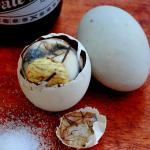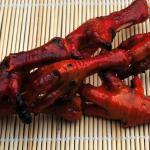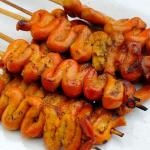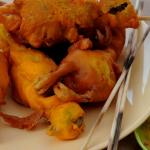Crazy, Crawly, Creepy and Crunchy
Text and Images by Ronald de Jong.
Food preparation, Styling and Props by Joemar Nazareno.
The Philippine archipelago is famous and notorious for its distinctive side-walk cuisine and the island of Mindanao has a bedazzling mélange of gratifying vittles as well. Taking a chunk out of these high flavored goodies can be a real culinary challenge; many first time visitors are avoiding these extreme eats for sanitary reasons or are afraid of consuming these daring foodies because it seems eerie and shocking, anyhow. It is beyond any doubt that these beguiling and exorbitant bites may not have a very attractive appearance and are not exactly a feast for the eyes or nose, on the other hand, it tastes better than it looks.
Marinated chicken and pork grilled on hot charcoal are the undisputable record-breaking nibbles; many are tempted by the meaty, salty, sweet, and spicy choices. Filipinos are creative, nothing is wasted, nearly every single bit of meat will be chewed down, one way or another and even the least palatable ingredients are grilled, fried, sizzled, stewed or steamed. Some ready-to-eat delicacies are given witty and funny names, mostly based on their suggestive form; like that skewer of crispy chicken wings, known as "PAL" named after the National Carrier Philippine Air Lines. “Isaw” is perhaps the top of the grill, simple yet pleasing, grilled or deep-fried pig- or chicken intestines on a wooden stick and served with sweet, sour sauce or dipped in vinegar with onions, peppers, and other spices (“Kurat”). The innards are thoroughly cleaned, turned inside out, and boiled before they are ready for grilling, there is nothing that can beat this strange twisted midnight munches. Because this smoky flavored nosh looks like an intra-uterine device it is locally called “IUD”. One of the popular street foods and a must try from these remarkably named concoctions is “Adidas”, a memorable name for something that's quite quirky, declawed chicken feet, marinated and grilled or done adobo style with a strong, savory flavor. It is named as Adidas because the chicken feet are three fingered and the trendy sports sneakers has three stripes in its logo. The “Betamax” is a showcase of the Filipino humorous nature, this awkward looking grub is curdled chicken- or pig's blood that is shaped into cubes and grilled. It is called Betamax thanks to its rectangular shape and black color, resembling the outdated Betamax videotape. It taste like meat and is served with vinegar or a different kind of sauce.
The “Helmet” is a different filler of hungry tummies and an appetizing adventure like no other, this tasty mouthful is an all-time hot seller for street food fanatics. It is nothing more than a deep fried or grilled chicken head, with the beaks and feathers removed but eyeballs, brains and sometimes the comb intact, marinated in a similar way as Isaw. The skin is peeled of and put down first, then the skull is broken and the brains are sucked out. A tiny meal called “One day old” is explicitly what it stands for, baby chickens just about a single day old; it is one of the boldest of all finger food. The newly-hatched male chicks are scorned by poultry farmers because they do not produce eggs. The skeleton of this mini cock-a-doodle-doo is not full-grown and still soft, only the bowels are removed so the crunchy fowl is almost entirely feasted on the chicklet is coated in reddish-orange flour and then fried to perfection. “Balut” frequently dubbed as “eggs with legs” and “treat with feet” is unmistakably one of most disreputable snack worldwide and at the same time the most preferred picking by many Filipinos; a fertilized poached duck egg, with a nearly-developed, healthy living embryo, between seventeen to twenty days in gestation and complete with recognizable features, close to ready to see the daylight. This high protein rarity is partaken in the shell and has a reputation to increase potency. Before the shard is peeled off, the broth surrounding the embryo can be sipped from the egg, after this the tender chick inside can be taken in. Balut is normally sold by street vendors out of metal buckets covered with a cloth to keep the eggs warm and served with small packets of salt or spiced vinegar.
Roasted pig, or “Lechon Baboy” for insiders, is a highlight of fiestas and other celebrations; lechon (Litson) Is a Spanish word for suckling pig. Any celebration would be incomplete without this symbol of the Philippine feast on the table, made in traditional style by stuffing the inside of the pig with a variety of herbs and vegetables, like onions, garlic, lemongrass and ginger. Preparing the cob-roller for consumption takes nearly a whole day; the body is soaked in hot water, shaved and thoroughly cleaned. The piglet is then slowly roasted for hours over a charcoal fire, resulting in tender meat with a dark brown and crispy skin. This regale is usually served with an apple between its jaws, carved, and taken in with a liver-based sauce. A more everyday grub is the “Walkman”, marinated pig's ears that are grilled on bamboo skewers. The ears are first cut into small pieces, boiled and scraped clean, these crispy ormers are probably the most sought morsel, devoured with spiced vinegar and usually consumed with alcohol, mostly a bottle of beer or rum. The name of this queer tidbid refers to the already out-dated portable music players. “Dila”, pickled, barbequed pig tongue is a good example of the more rare bites, it is normally sold grilled and used in a variety of ways.
Bugs, insects, snakes, frogs, bats, snails and rats are some of the most fascinating and useful animals that are found in nature, they help plants to reproduce, recycle natural material and serve as a food source for other living things, including humans. Many of Mother Nature’s sneaking and dragging critters can be creepy-looking, but they are likewise the main ingredient in the Filipino cuisine and are thought of as crunchy bites. “Kamaru”, (Mole Crickets), many people refer to them as rice field crickets because they are found mostly on rice fields. This Bug-a-Boo is just one of those crowd-pleasing victuals, when cooked every bit of these flying longlegs can be digested, but many would rather take off the claws, legs and wings. They can be stir-fried without oil or seasoning, but usually they are prepared as Adobong Kamaru; the cricket bodies are first boiled in vinegar and garlic then sautéed in oil, onion and chopped tomatoes until they are crispy on the outside and moist in the middle. Their sapor is something like liver and served with cold beer it is regarded as a favourite “Pulutan” (finger food). “Tipaklong” or Grasshoppers are a real nuisance for farmers; they can bring plague or eat their crops. Nevertheless, these arthropods make a great stir-fry when sautéed and sauced with vinegar, onions, and tomatoes. They are regularly eaten sun-dried without wings and legs or grinded into flour. Moreover, these insects can be roasted on a barbecue; then cut into pieces or broiled as a whole with salt and seasonings. This exotic order taste like shrimp and can be served as an appetizer and dessert. Next there are the June Bugs; they are collected along the river banks, mostly after a summer rain. These clammy cooties can be eaten as a larva or full grown beetle, they have to be soaked in salt water overnight and the legs and wings have to be removed before consumption. This odd aliment is named “Salagubang”, it can be roasted on coal, sautéed in soy sauce, fried or heated on a stove-top or microwave as it was popcorn and it is reckoned to give a walnut flavour. “Kuhol” is the Filipino name for the Apple- or Golden Snail, this slow moving slug is made into “Guinataang Kuhol”, a much favored canapé when sautéed with garlic, ginger, onions, pepper and coconut cream. The “Taklong” or “Korakol” are forest snails that are living on trees and plants; they carry an over-sized, dark brown coiling shell on the back and leave traces of orange colored slime wherever they crawl. This will not withhold the natives of turning this gooey woodland dweller into an exquisite dish tagged as “Adobong Taklong” (pickled forest snail); the snails are cut into small pieces and simmered. Other tempting highlights are “Guinisang Taklong” (sautéed forest snail) or “Barbekyung Taklong” the gummy gizzards are marinated in barbecue sauce, skewered on a bamboo stick, grilled over an open fire and served with vegetables.
Rice field rats are widely spread all over the island and thrive on the fertile farm lands. Farmers consider them as a pest because they eat and destroy the rice plants. Traps and poison are only a couple of ways to eradicate these infestive vegetarians, eating them is another. After the skin is removed, the head, tale and legs are cut of and the internal organs are removed they can be transformed into cooking’s like “Pritong Dagang Bukid”; Crispy, Fried Rat, “Ginataang Daga,” made with coconut milk, “Sinampalukang Daga.”, used with Tamarind and “Adobong Daga”, simmered Rat Meat or simply deep-fried. The rice paddies are home to many more sliding, hopping and wriggling varmints. Rats and frogs are likely the most essential food source for snakes that are also living in the rice fields. Frogs play a very important role in the ecosystems but are not only a much wanted prey for snakes. In the rainy season, as soon as sunset sets in, children from the barrios go out in the fields to catch the edible rice field frogs “Palaka”; they shine with a flashlight into the frog's face and catch them with bare hands. The frog is favoured for its edible legs that taste like chicken and are nibbled right of the bone. The green/brown croaker can be done “Adobe” style, stewed in vinegar and soy sauce, with peppercorns and bay leaf, deep fried (“Sinampalukan”), roasted, stewed and made into “Rellenong Palaka”; the jumping amphibian is then stuffed with ground meat.
In its turn the snake has long been part of the food chain and the regional cuisine, this roaming reptile is a tasty scrunch, when skinned and marinated in garlic, vinegar, soy sauce and other seasonings it is named “Adobong Ahas” or Snake Adobo. Snakes have a kind of chicken flavour when grilled or roasted or smouldered. It is said that snake meat has a medicinal value and is understood to be an aphrodisiac. The crocodile is one more swimming, crawling and lunging that, just like the snake, lives at the margins of the water and land that on many occasions is inhabited by the human race. When it comes to necessities for their existence, people will swallow nearly anything that crawls, slithers, flies and swims and that is prowling in their own backyard, fields, lakes and forests. In reality; they will practically adjust almost everything to fill their empty stomachs and even this frightening, cold-blooded vertebrate could not escape the need to satisfy the cravings of these two legged omnivores. So, there are various crocodile based dishes, such as “Braised Crocodile Paws”, “Braised Crocodile Shank”, “Crunchy Croc Wings”, “Crispy Crocodile Pata”, “Sisig Crocodile”, “Lechon Crocodile”, “Crocodile Gumbo”, “Crocodile Sausages” and “Fresh Crocodile Pasta”. The white meat of the sharp-toothed reptile is kind of hard to chew but it has unique characteristics, the texture is somewhat similar to pork and the savour is comparable with whitefish. A special dessert is “Crocodile Ice Cream”; a frozen sweet that is made from a combination of milk and the eggs from the crocodile.
The island of Samal, east of the mainland of Mindanao, holds the largest colony of fruit bats in the world. Despite the fact that these flying, nocturnal, mouse like mammals, along with snakes and crocodiles, is one of the most feared creatures, locals believe that eating the bat is good for curing coughs and asthma. Fruit bats can be smoked, braised in coconut milk and simmered. The fur is burned off, the bat is skinned, the stomach is removed, and the glands are taken of the limbs. The remainder has no recognizable features anymore and is chopped into small pieces, sautéed in oil, garlic, vinegar, tomatoes, pepper and laurel leaves. The dish, “Paniki” is supposed to have a bite like duck. Although many people consider these fruit bats a delicacy, hunting and eating them should be stopped because of the decreasing population of the fruit bats. The mangrove forests on Samal Island and those across the Davao Gulf in Davao are home to the “Tamilok”, popularly described as woodworm. Anyway, it looks likes a worm but is in fact a kind of elongated, distasteful looking Mollusk that can grow up to a foot long and is thriving inside rotting driftwood. After being caught, the insides are removed and this slimy grub is washed and cleaned. It is dashed with lemon, soaked in spicy vinegar, served Kinilaw style; raw with chopped onions, chilli, and customarily scarfed down alive. Some people say it has to be chewed upon a little bit before its sapidity can be enjoyed fully; others think it is better to swallow it whole. The aftertaste is similar to that of an oyster and gives a titillating sensation on the tongue. One of the most common creepers in the Mindanao countryside is the”Tuko”, alias the “Tokay Gecko”. Every home has some of these lizards that are scurrying around on ceilings and crawling on walls. There are people who claim that this ubiquitous nocturnal mosquito killer, when dried, grilled or crispy fried, is as tasty as chicken. In folkloric practices geckos are an additive as tea or ground into powder and used as medicinal. It is presumed to be a cure for asthma, impotence and other diseases, though there is no scientific proof what so ever. A far relative of the Tokay Gecko is the Monitor Lizard or “Bayawak”; this scrumptious reptile is the largest lizard found in the Philippines, mostly in Mindanao, Basilan and Sulu, and can become as large as two meters in length. After being caught they are dried, hung up in bundles at roadside stalls and markets and sold for a high price. Its eggs (“Itlog”) can be boiled and are a bit salty, the mini dragon itself is skinned, disembowelled, beheaded and chopped into small pieces, it can be cooked with coconut milk or sautéed in garlic and onion, ginger and laurel leaf with pepper, soy sauce, and vinegar. The Bayawak is a protected species in the Philippines, nonetheless; it is until today hunted for their skin and its meat is well liked in rural areas and big city restaurants.
Anyhow, if there is plenty of backbone, if the belly is strong enough, if there is a real culinary open-mindedness, a will to forget the usual fare of hamburger, pizza or hotdogs and if there are enough guts not to stick to what is or looks familiar, feel free to try out the more unknown native take away. Gobbling up these fried eyeballs, scooping out grilled brains, seared ears and tongue, roasted intestines, boiled duck fetus, dried blood, baby gumps, bizarre bugs, brown rodents and other strange looking bodily parts are an inspiring way to discover the tastes from the streets and fields. There are more then enough different curb-side pickings waiting to be discovered and all of these tantalizing take-away specialties are definitely worth a best shot, just to name a few; “Tokneneng”, “Pusit”, “Penoy” , “Ginataang”and “Kwek-Kwek”. Well, there is always a chance to find out what it is; which one will tickle the taste buds and can satisfy the stomach. For all that; enjoy these bugged out platefuls; they will surely be some to remember!
 ThingsAsian
ThingsAsian



















